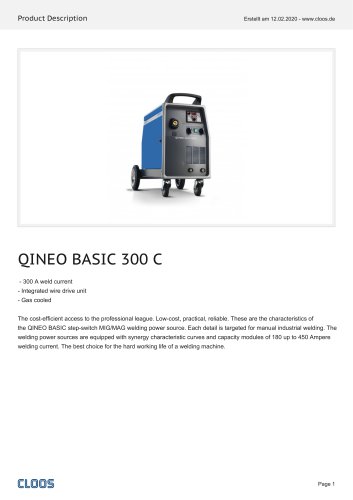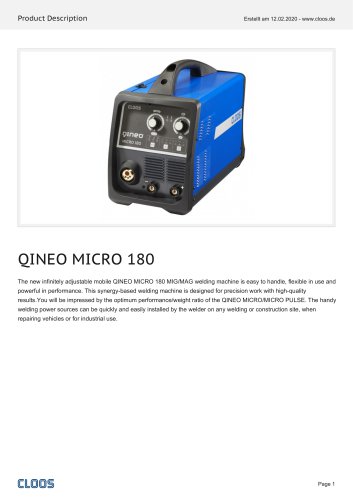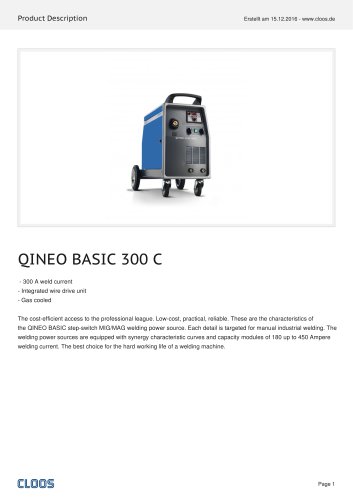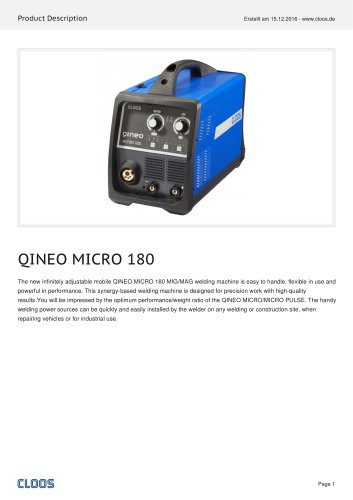
カタログの抜粋
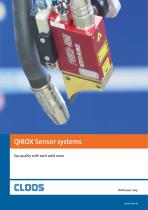
QIROX Sensor systems Top quality with each weld seam
カタログの1ページ目を開く
Tactile gas nozzle sensor Page 6 Laser offline sensor Page 10 Laser online sensor Page 12 Technical Data Page 14
カタログの2ページ目を開く
Sensitivity to perfect welding processes With our QIROX® system solution for automated welding and cutting we can integrate state-of-the-art welding technology into your welding production. The main task of our sensor systems is to ensure quality control through precise welding procedures. The flexibility of your systems increases due to the control and compensation of tolerances between the programmed paths and the real workpieces. Four CLOOS sensors which have been proven in the field are available for the most varied materials and applications; these sensors are able to further improve...
カタログの4ページ目を開く
The right sensor always available With intensive consultation we can develop complete solutions to meet your requirements. To generate maximum efficiency and effectiveness by automating the welding processes, all components are individually matched to the relevant production conditions and requirements. This applies in particular to the field of sensor technology, where we have developed four products with different capacity ranges: tactile gas nozzle sensor, arc sensor, laser offline sensor and the laser online sensor. These sensors have different tasks depending on the production...
カタログの5ページ目を開く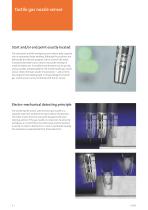
Tactile gas nozzle sensor Start and/or end point exactly located The start point and the workpiece joint contour play a special role in automated robot welding. Although the positions are defined by the relevant program which controls the robot, in practice deviations occur due to inaccurate settings or material tolerances. To enable these deviations to be quickly and accurately compensated for, the CLOOS tactile gas nozzle sensor checks the start and/or end positions – and corrects the programmed welding path correspondingly. The tactile gas nozzle sensor can be combined with the arc...
カタログの6ページ目を開く
Measuring the seam volume If both positions are defined, the linear run of the weld seam is determined automatically. In the case of a V seam the tactile CLOOS gas nozzle sensor also measures the seam volume according to the same principle. After saving the information in the user program, the robot fills the seam along the optimised path. The main advantage is a perfect welding result as a basis for a reliable quality. Tasks ■ Detection of the start and/ or end position ■ Definition of the workpiece position ■ Determination of the linear welding path ■ Measurement of the seam volume in the...
カタログの7ページ目を開く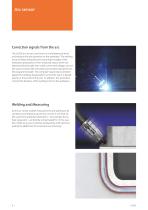
Correction signals from the arc The CLOOS arc sensor uses the arc to simultaneously weld and measure the joint position on the workpiece. The welding torch oscillates along the joint scanning the edges of the weld seam preparation. If the measured values, which are obtained electronically from weld current and voltage, are not the same on both sides, the weld seam position deviates from the programmed path. The computer-based robot controller adjusts the welding head position so that the seam is placed exactly in the centre of the joint. In addition, this procedure corrects the distance of...
カタログの8ページ目を開く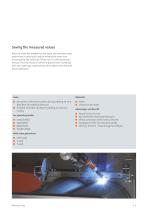
Saving the measured values After the robot has welded the root seam, the correction data determined is saved and used for welding the cover runs ensuring that the build-up of these runs is continuously optimised. The final result is further improved when combined with the CLOOS gas nozzle sensor, which determines the start of the weld seam. Materials ■ Steels ■ Chrome nickel steels Advantages and benefit ■ Nearly no loss in time ■ No interference from attached parts ■ Direct connection to the robot controller ■ Adaptation of the correcting sensitivity ■ Memory function - data storage for...
カタログの9ページ目を開く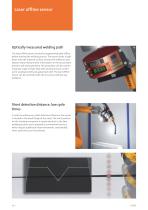
Laser offline sensor Optically measured welding path The laser offline sensor tracks the programmed path offline before starting the welding process. The sensor sends a light beam onto the material surface, receives the reflection and obtains every measurement information on the actual seam position and seam geometry. This procedure can be used for materials made of high-alloy steel and aluminium as well as for unalloyed steel and galvanised steel. The laser offline sensor can be combined with the arc sensor without any problems. Short detection distance, low cycle times In order to achieve...
カタログの10ページ目を開く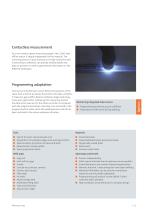
Monitoring Integrated video camera ■ Programming aid where access is difficult ■ Observation of the torch during welding Contactless measurement As a non contact optical measuring system, the CLOOS laser offline sensor is largely independent of the material. The scanning process is quick and due to its high resolution and insensitivity to reflection can provide reliable details and data on positions as well as geometrical information on the different weld types. Programming adaptation During scanning the laser sensor detects the position of the seam start and end, as well as the position of...
カタログの11ページ目を開く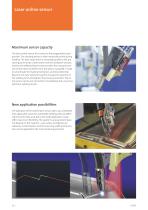
Laser online sensor Maximum sensor capacity The laser online sensor first moves to the programmed start position. The tracking section is then measured online during welding. The laser head which is mounted parallel to the processing point sends a laser beam onto the workpiece surface, receives the reflected beams and transfers the measured results to the robot controller. Here the data is evaluated in order to compensate for material tolerances and heat distortion. Based on the new values the system changes the position of the welding torch and adjusts the process parameter. The online...
カタログの12ページ目を開く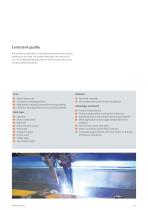
Consistent quality If the tolerance deviations indicated by measurements during welding are too high, the system interrupts the production run. This integrated quality control inhibits faulty welds, thus avoiding extensive rework. Tasks ■ Search seam start ■ Correction of tooling position ■ Adaptation of process parameters during welding ■ Control of the edge offset in the case of butt welds Weld types ■ Lap joint ■ Multi overlap weld ■ Butt joint ■ Butt joint with air gap ■ Fillet weld ■ V weld, HV weld ■ Corner weld ■ Flange weld ■ Special seam types Materials ■ Nearly all materials ■...
カタログの13ページ目を開くCLOOSのすべてのカタログと技術パンフレット
-
QINEO MICRO 1802020
3 ページ
-
QINEO MICRO 300
3 ページ
-
QIROX Entry Package
12 ページ
-
QIROX RoboPlan
16 ページ
-
QIROX Compact cells
32 ページ
-
QIROX Welding robots
32 ページ
-
QIROX Compact systems
40 ページ
-
QINEO NexT
32 ページ
-
QINEO – Product Overview
44 ページ
-
Welding
32 ページ
-
Grinding Solution
4 ページ
-
QIROX Laser Cell
12 ページ
-
QIROX QC2 Master
2 ページ
-
QIROX QC2 Advanced
2 ページ
-
C-Gate
4 ページ
カタログアーカイブ
-
Standard head
2 ページ
-
QWD-AR
2 ページ
-
QWD-M2
2 ページ
-
QINEO NexT 452 DC
2 ページ
-
QINEO CLE 352 (DC)
3 ページ
-
QINEO CHAMP 451 PRO
3 ページ
-
QINEO STEP 250 C
3 ページ
-
QINEO CHAMP 450
4 ページ
-
QINEO Plasma Cut 30
3 ページ
-
QINEO STEP 350 C
3 ページ
-
QINEO MICRO 180 2016
3 ページ
-
QINEO® PULSE
10 ページ
-
QINEO® STEP
8 ページ



